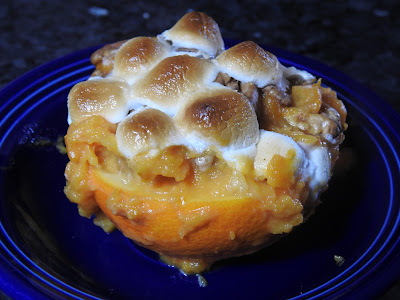Rosie loves her ice cream.
It was a Sunday afternoon.
I wanted ice cream
I was lazy.
I didn't want to go to Food Lion.
I wanted MY ice cream.
I wanted butter pecan.
So I made it.
Ice cream is simple.
You start out with a basic custard
and you go from there with whatever flavors you want.
And like I said,
I wanted butter pecan.
So come along with Rosie
as she makes up a butter pecan ice cream.
Rosie's Butter Pecan Ice Cream
2 ½ cups heavy cream
¾ cup skim milk
¾ cup sugar
⅓ cup light brown sugar
1 TB vanilla
3 egg yolks
1 cup heavy cream
2 TB unsalted butter
1 cup pecans
1TB light brown sugar
Combine cream, milk, sugars, and vanilla in sauce pan.
Heat until simmering, stirring.
In a medium bowl, whisk eggs.
Slowly pour about a cup of hot mixture into yolks,
whisking constantly.
Pour yolk mixture back into sauce pan
and cook over low to medium heat until mixture thickens.
Let mixture cool.
If you're like me,
you can't wait for the mixture to cool.
So I poured a semi-warm custard mixture
into my ice cream maker
into my ice cream maker
and started it up.
After a few minutes,
I poured in the rest of the heavy cream (1 cup).
Cold.
While the machine was turning and churning,
I buttered my pecans.
Melt the butter in a skillet over medium heat
and add the pecans and brown sugar.
Cook, stirring, until sugar melts
and pecans are nice and toasty.
Let cool a bit and add to ice cream
near the end of processing.
Mr. Hawthorne says this is the best butter pecan ice cream
he's ever had.
But then I made it even better.
I made CARAMEL Butter Pecan Ice Cream.
Caramel Butter Pecan Ice Cream
1 cup whipping cream
7 oz. skim milk
2 oz. whipping cream
1/2 cup sugar
1/4 cup brown sugar
1 TB vanilla
3 yolks
1 cup whipping cream
1 cup skim milk
Make the custard:
Heat cream, milk, sugars, and vanilla
over medium heat until boil.
Whisk yolks,
then slowly pour 1-2 cups of hot milk mixture
into yolks, whisking constantly.
Pour egg mixture back into sauce pan
and cook over low heat until mixture thickens.
Remove from heat and chill.
Buttered Pecans
1 cup pecans
4 TB unsalted butter
1/4 cup brown sugar
Mix all together in medium skillet
and sauté until sugar is melted
and pecans are toasty.
Let cool.
Caramel
1/2 cup brown sugar
4 TB unsalted butter
2 TB heavy cream
1 tsp vanilla
pinch kosher salt
In small sauce pan over medium low heat,
combine brown sugar, butter, and cream.
Heat, stirring, until sugar is melted
and mixture starts to thicken.
Stir in vanilla.
Add a pinch of salt.
Let cool a bit.
MAKE THE ICE CREAM:
Start processing the custard mixture.
Stir in an extra cup of whipping cream
and a cup of skim milk.
Continue processing,
scraping the frozen mixture down from
the sides and paddle as needed.
When the ice cream is almost done,
stir in the pecans and continue processing.
At the very end, drizzle in the caramel mixture.
You don't want to totally combine the caramel.
You want pockets of caramel.
Spoon into containers and freeze.
To serve,
you might just want to try adding a plop
of Caramel Butter Pecan Ice Cream
alongside Pecan Caramel Bundt Cake.
This is a life-changing experience.
But then I made it even better.
I made CARAMEL Butter Pecan Ice Cream.
Caramel Butter Pecan Ice Cream
7 oz. skim milk
2 oz. whipping cream
1/2 cup sugar
1/4 cup brown sugar
1 TB vanilla
3 yolks
1 cup whipping cream
1 cup skim milk
Make the custard:
Heat cream, milk, sugars, and vanilla
over medium heat until boil.
Whisk yolks,
then slowly pour 1-2 cups of hot milk mixture
into yolks, whisking constantly.
Pour egg mixture back into sauce pan
and cook over low heat until mixture thickens.
Remove from heat and chill.
Buttered Pecans
1 cup pecans
4 TB unsalted butter
1/4 cup brown sugar
Mix all together in medium skillet
and sauté until sugar is melted
and pecans are toasty.
Let cool.
Caramel
1/2 cup brown sugar
4 TB unsalted butter
2 TB heavy cream
1 tsp vanilla
pinch kosher salt
In small sauce pan over medium low heat,
combine brown sugar, butter, and cream.
Heat, stirring, until sugar is melted
and mixture starts to thicken.
Stir in vanilla.
Add a pinch of salt.
Let cool a bit.
MAKE THE ICE CREAM:
Start processing the custard mixture.
Stir in an extra cup of whipping cream
and a cup of skim milk.
Continue processing,
scraping the frozen mixture down from
the sides and paddle as needed.
When the ice cream is almost done,
stir in the pecans and continue processing.
At the very end, drizzle in the caramel mixture.
You don't want to totally combine the caramel.
You want pockets of caramel.
Spoon into containers and freeze.
To serve,
you might just want to try adding a plop
of Caramel Butter Pecan Ice Cream
alongside Pecan Caramel Bundt Cake.
This is a life-changing experience.






































































